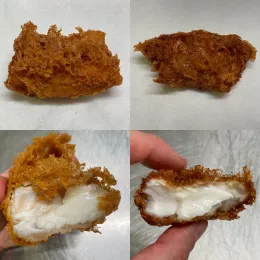Institute of Culinary Education chefs are developing recipes with Italy's authentic Balsamic Vinegar of Modena. Here, Chef Barry uses the ingredient to add texture and acidity to a seafood dish.
This dish uses simple and fresh ingredients and showcases them at their best. I used fresh scallops, very finely sliced; a peppery nasturtium oil made with nasturtium leaves; red grapes for sweetness; and finally, the Balsamic Vinegar of Modena pearls to finish with acidity and a beautiful texture. The creamy balsamic really pops in the mouth.


Ingredients
For the scallops:
- 1 large scallop cleaned, very finely sliced
For the nasturtium oil:
- 40 grams nasturtium leaves, cleaned
- 80 grams grapeseed oil
- Salt
For the balsamic “caviar”:
- 100 grams Aceto Balsamico di Modena PGI
- 8.3 grams calcium lactate
- 2.5 grams sodium alginate
- 500 grams water
To finish:
- 6 red grapes, sliced into discs
- 5 nasturtium leaves
- 3 nasturtium flowers
- 1 pinch Maldon sea salt
Directions
- Remove the scallop from the shell; remove roe and attached muscle. Clean and dry well. Slice scallop very finely.
- Prepare nasturtium leaves, removing stalks. Discard any discolored leaves. Blanch in salted water for 15 seconds and immediately plunge into iced water. Drain leaves and squeeze gently, removing excess water. Place in a VitaPrep and add grapeseed oil along with a small amount of salt.
- Blend on high until almost completely pureed, around 30 seconds. Remove and place contents into a small saucepan.
- Prepare a chinois inside a metal container over iced water. Place a double layer of cheesecloth inside chinois. Heat nasturtium mixture on high (preferably induction) and allow the oil to split. The oil should fry from the outside in. Once it is frying in the center, remove and quickly transfer into cheesecloth-lined chinois. Leave to cool.
- For the balsamic “caviar,” gently heat Balsamic Vinegar of Modena in a small saucepan until warm. Add calcium lactate and blend with immersion blender until incorporated, leave to cool. Using an immersion blender, blend water and sodium alginate until dispersed fully. Leave to hydrate for at least 1 hour.
- Add cooled balsamic mixture to a syringe or squeeze bottle. Drop mixture into prepared alginate bath, 4 inches from the alginate water mixture. Leave to set for around 1 minute.
- Remove pearls from the alginate bath using a slotted spoon and place into a container of fresh water to stop the spherification process. Drain pearls onto towel for plating.
- Place the scallop slices on the base of the plate, brush with nasturtium oil and season well with Maldon sea salt. Place grape slices around the edge of the scallops. Top with balsamic “caviar,” and dress with nasturtium leaves and flowers.
Explore more Balsamic Vinegar of Modena recipes, and start your own research in ICE's Culinary Arts program.




